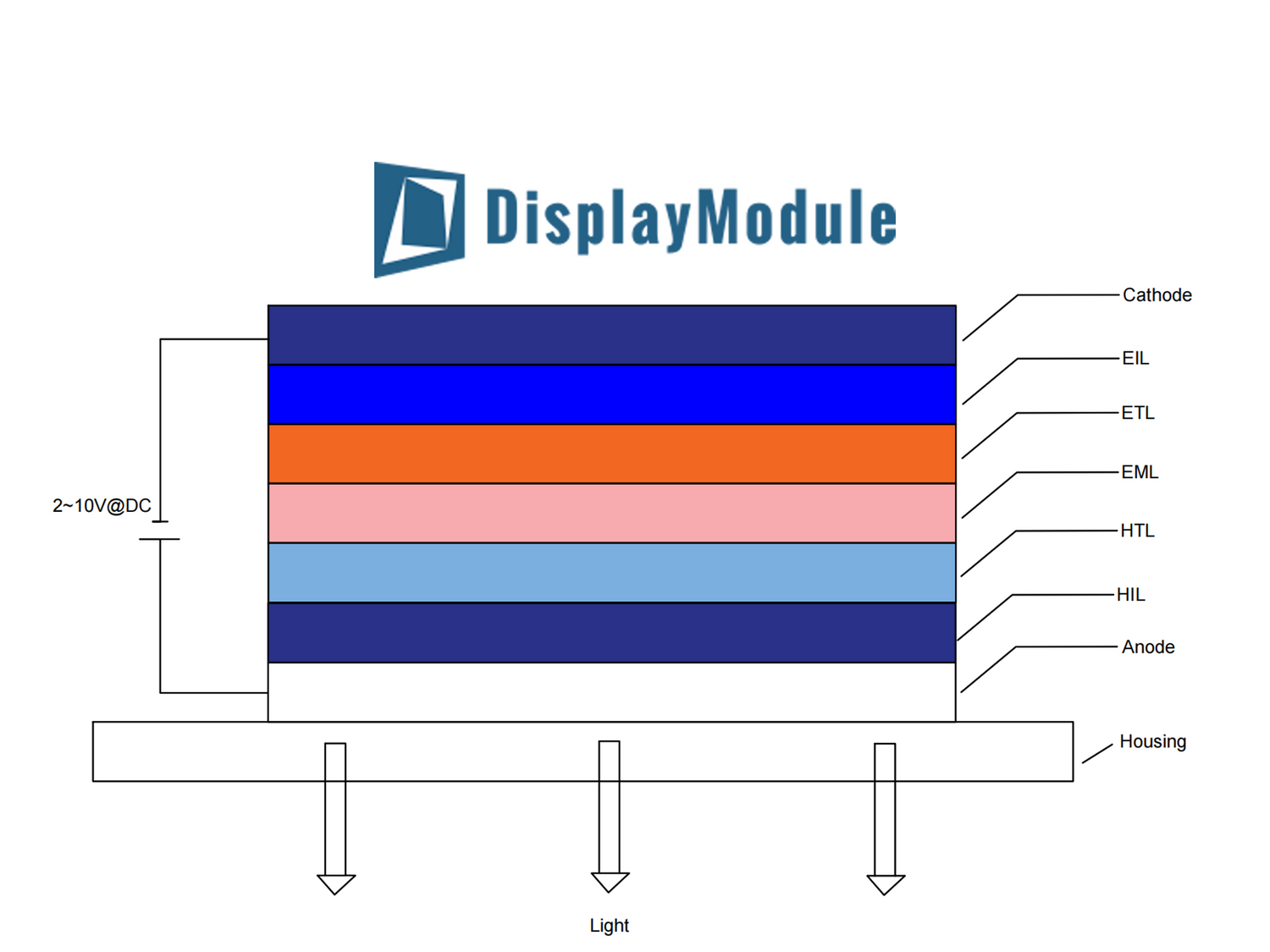
How OLEDs Work? - OLED Structure & Principle of Luminescence
DisplayModuleInfo
OLED(Organic Light Emitting Diode),The principle is that an organic light-emitting layer is sandwiched between two electrodes. When the positive and negative electrons meet in this organic material, it will emit light. It's component structure is simpler than the current popular TFT LCD, and the production cost is only one-third to one-quarter of the TFT LCD. In addition to the cheap production cost, OLED has many advantages, such as its own light-emitting characteristics. Currently, LCD requires a back-light module ( leds are added behind the liquid crystal), but OLED will emit light by itself after it is powered on, which can save the weight of the leds. Volume and power consumption (the power consumption of the leds tube accounts for almost half of the entire LCD screen), not only the thickness of the product is only about 2mm, but the operating voltage is as low as 2 to 10 volts, and the response time of the OLED (less than 10ms) .And the color is better than TFT LCD, more flexible characteristics.
1.3" 128x64 Monochrome Graphic OLED Display Module - SPI

The basic structure of OLED is to make a layer of organic light-emitting material with a thickness of tens of nano on indium tin oxide (ITO) glass as the light-emitting layer, and there is a layer of metal electrodes with low work function above the light-emitting layer to form a sandwich-like structure.
OLED Structure

- Housing (transparent plastic, glass, metal foil): used to support the entire OLED.
- Anode (transparent): Holes need to be injected into the OLED, so it needs to have a higher work function. Commonly used anode materials are ITO, IZO, Au, Pt, Si and so on.
- HIL (Hole Inject Layer): Due to the large HOMO (Highest Occupied Molecular Orbital) energy level difference between the anode and the hole transport material, increasing the hole injection material will help to increase the charge injection between the interfaces, and finally improve the efficiency and life of the device.
- HTL (Hole Transport Layer): This layer is composed of organic material molecules that transport "holes" from the anode.
- EML (Emission layer): This layer is composed of organic material molecules (different from the conductive layer), and the light-emitting process is carried out in this layer.
- ETL (Electron Transport Layer): This layer is composed of organic material molecules that transport "electrons" from the cathode.
- EIL (Electron Inject Layer): Helps electrons to be injected into organic materials from the cathode. The role of the injection layer is to make the anode work function LUMO (Lowest Unoccupied Molecular Orbital) level well matched with the cathode work function and HOMO level, so that electrons and holes can smoothly flow from the electrode to the transport layer.
-
Cathode (can be transparent or opaque, depending on the type of OLED): The most basic condition for the choice of cathode material is that electron injection is easy. Therefore, a low-power material needs to be selected as the cathode of the OLED. Using a material with a low work function as the cathode can not only improve the electron injection efficiency, but also reduce the Joule heat generated during the operation of the OLED, and improve the life of the device. Common cathode materials and structures are listed below:
- Metal elements: Ag, Al, Li, Mg, Ca, In, etc. Elemental metals are active and easily oxidized, resulting in shortened life.
- Alloy material: Mg:Ag(10:1), Li:Al(0.6%Li), etc. Active and low work function metals and their chemical properties
OLED luminescence principle
The light-emitting process of OLED usually has the following 5 basic stages:

-
Carrier injection: Under the action of an external electric field, electrons and holes are injected from the cathode and anode respectively to the organic functional layer sandwiched between the electrodes.
-
Carrier transport: The injected electrons and holes migrate from the electron transport layer and the hole transport layer respectively to the light-emitting layer.
-
Carrier recombination: After electrons and holes are injected into the light-emitting layer, they are bound together by the Coulomb force to form electron-hole pairs(excitons).
-
Exciton migration: Due to the imbalance of electron and hole transport, the main exciton formation region usually does not cover the entire emissive layer, so diffusion migration occurs due to concentration gradients.
-
Exciton radiation de-excites photons: exciton radiation transitions, emits photons, and releases energy.
The color of OLED light emission depends on the type of organic molecules in the light-emitting layer. Several organic thin films are placed on the same OLED to form a color display. The brightness or intensity of light depends on the properties of the light-emitting material and the magnitude of the applied current. For the same OLED, the higher the current, the higher the brightness of the light.
